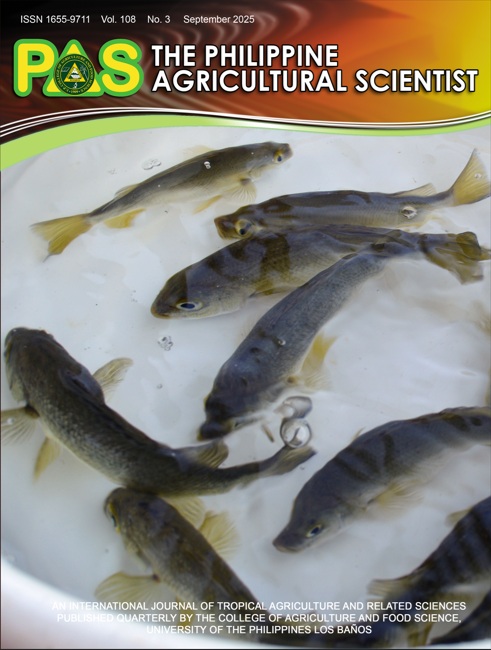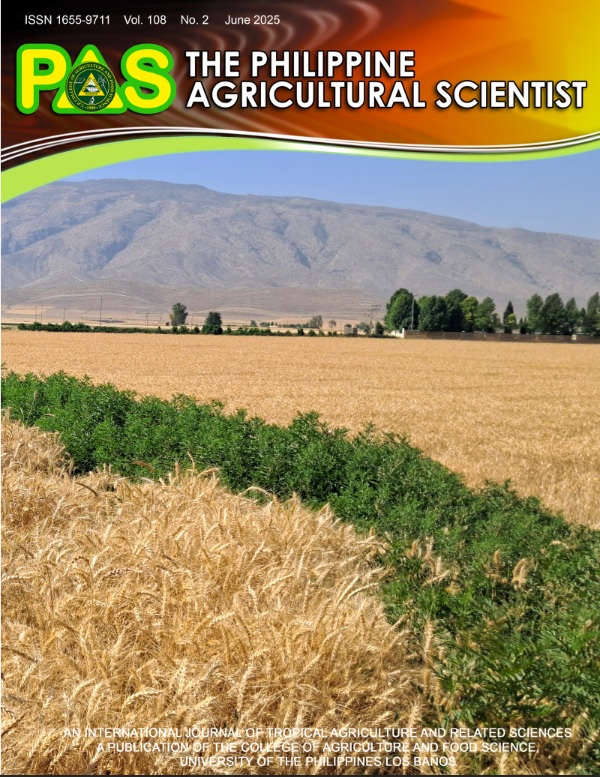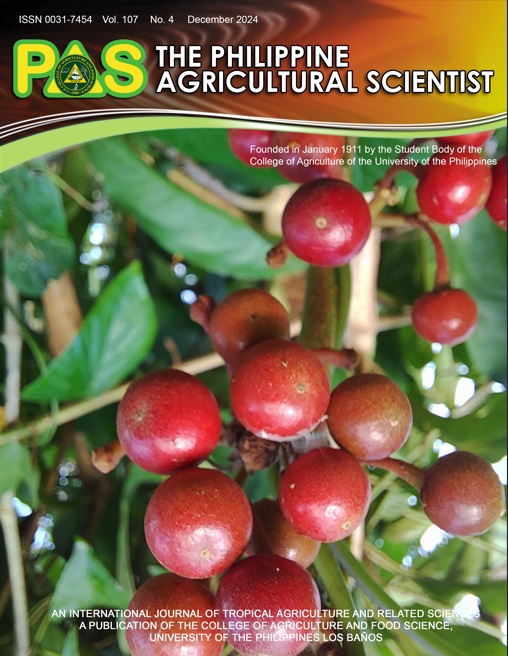-
 Vol. 108, No. 3 (Sep 2025)
Vol 108 No 3 (2025)
Vol. 108, No. 3 (Sep 2025)
Vol 108 No 3 (2025)Wild and hatchery-bred silver therapon, locally known as ayungin. This fish species is a popular food fish in inland rural communities and is important to the lake’s subsistence fishery. However, it is now considered the most exploited freshwater fish species in the Philippines. {Photograph courtesy of Dr. Frolan A. Aya, Binangonan Freshwater Station, SEAFDEC Aquaculture Department.}
-
 Vol. 108, No. 2 (Jun 2025)
Vol 108 No 2 (2025)
Vol. 108, No. 2 (Jun 2025)
Vol 108 No 2 (2025)Wheat fields in Western Iran. Water scarcity poses a significant challenge to securing staple food supplies for the country’s population. The effects of mycorrhiza, Azotobacter, and Azospirillum biofertilizers on two common wheat cultivars in Western Iran—Chamran and Behrang—were therefore evaluated to explore the role of biofertilizer application in improving yield and key morphological traits under water stress. {Photograph courtesy of Dr. Bahram Amiri, Department of Agriculture, Fir.C., Islamic Azad University, Firoozabad, Iran.}
-
 Vol. 108, No. 1 (Mar 2025)
Vol 108 No 1 (2025)
Vol. 108, No. 1 (Mar 2025)
Vol 108 No 1 (2025)A collage showing the inflorescence of Hoya ilagiorum in vibrant red color (left photo); H. ‘Moonlight’ with dainty yellow umbel (upper right corner photo); H. ‘Sunkissed’ with yellow-orange flowers (middle right photo) and H. ‘Starburst’ with striking two-toned yellow and red-purple corolla and mallow purple corona (lower right corner photo).
{Photographs courtesy of Jennelyn C. Bengoa and Gerlie P. Antesco, Institute of Plant Breeding, College of Agriculture and Food Science, University of the Philippines Los Baños.}
-
 Vol. 107, No. 4 (Dec 2024)
Vol 107 No 4 (2024)
Vol. 107, No. 4 (Dec 2024)
Vol 107 No 4 (2024)A collage showing the inflorescence of Hoya ilagiorum in vibrant red color (left photo); H. 'Moonlight' with dainty yellow umbel (upper right corner photo); H. 'Sunkissed' with yellow-orange flowers (middle right photo) and H. 'Starburst' with striking two-toned yellow and red-purple corolla and mallow purple corona (lower right corner photo).
{Photographs courtesy of Jennelyn C. Bengoa and Gerlie P. Antesco, Institute of Plant Breeding, College of Agriculture and Food Science, University of the Philippines Los Baños.}
-
 Vol. 107, No. 3 (Sep 2024)
Vol 107 No 3 (2024)
Vol. 107, No. 3 (Sep 2024)
Vol 107 No 3 (2024)The katmon (Dillenia philippinensis) flower has five fragrant white petals which are large, showy, and about 15 cm in diameter with reddish pistils and stamens. It is solitary and terminal. Flowers in full bloom may shed their petals on the same day or after, then the fruit starts to develop.
{Photograph courtesy of Dr. Amparo M. Wagan, Agricultural Systems Institute, College of Agriculture and Food Science, University of the Philippines Los Baños.}
-
 Vol. 107, No. 2 (Jun 2024)
Vol 107 No 2 (2024)
Vol. 107, No. 2 (Jun 2024)
Vol 107 No 2 (2024)Philippine native roosters Banaba, Joloano, and Paraokan. These animals were used to established baseline data on the quantity and quality of fresh avian semen.
{Photograph courtesy of Dr. Percival P Sangel, Institute of Animal Science, College of Agriculture and Food Science, University of the Philippines, Los Baños, College, Laguna}
-
 Vol. 107, No. 1 (Mar 2024)
Vol 107 No 1 (2024)
Vol. 107, No. 1 (Mar 2024)
Vol 107 No 1 (2024)Sweet potato tuber infested with sweet potato weevil, Cylas formicarius Fabr. The weevil infests sweet potato plants as early as two weeks after planting but targets the tubers, causing economic losses (Capinera 2021).
{Photograph courtesy of Jerah Mystica B. Novenario, College of Agriculture Systems and Technology, Pampanga State Agricultural University.}
-
 Vol. 106 No. 4 (Dec 2023)
Vol 106 No 4 (2023)
Vol. 106 No. 4 (Dec 2023)
Vol 106 No 4 (2023)BUFFALO CALVES. Calves eventually serve as the productive unit of the herd and need to be protected, managed, and fed properly for their population to grow economically at an optimum rate. Underfeeding significantly reduces growth rates to 50% during the rearing phase which may cause delayed puberty. Castillo et al. (2023) studied the effects of hydroponic corn fodder on the growth performance of buffalo calves. Supplementing buffalo calves’ diets with hydroponic corn fodder could have a beneficial effect on their growth performance and economic viability. Overall, hydroponic corn production has a great potential as a sustainable source of fodder for ruminants to support the nutritional requirements.
{Photograph courtesy of Mikee A. Antonio, Philippine Carabao Center at Central Luzon State University, Science City of Nueva Ecija}
-
 Vol. 106 No. 3 (Sep 2023)
Vol 106 No 3 (2023)
Vol. 106 No. 3 (Sep 2023)
Vol 106 No 3 (2023)Mango (Mangifera indica L.) cv. Carabao. This export cultivar, known for its superior taste and quality, has limited marketability and shelflife due to its perishability and susceptibility to postharvest diseases. A study conducted by Montecalvo et al. (2023) explored the disease-reducing effect of generally regarded as safe (GRAS) compounds like calcium salts against stem end rot and anthracnose diseases. Results showed that calcium chloride and calcium carbonate have antifungal activity against the fungal pathogens inciting these diseases. Their control efficacy was comparable with the standard postharvest hot water treatment (HWT) but HWT was more effective in reducing anthracnose disease. Validation studies could indicate their potential benefit as postharvest treatments.
{Photograph courtesy of Ms. Melissa P. Montecalvo, College of Agriculture and Food Science, University of the Philippines Los Banos}
-
 Vol. 106 No. 2 (Jun 2023)
Vol 106 No 2 (2023)
Vol. 106 No. 2 (Jun 2023)
Vol 106 No 2 (2023)PILI NUT (CANARIUM OVATUM ENGL.) CV. MAYON KERNEL. Pili nut is an indigenous crop in the Philippines, widely cultivated in the Bicol region. It is also a rich source of protein and other nutrients. Studies have been made in assessing the health benefits of its oil content, but very few have looked into the bioactivities of its proteins. Gamba et al. (2023) studied the antihypertensive and antioxidative properties of the proteins from the Pili nut kernel. Results showed evidence of higher antihypertensive activity as compared to the conventional antihypertensive drugs with high antioxidative activity. This study is a very significant drug discovery and food supplement development, resulting to high commercial value of the Pili nuts.
{Photograph courtesy of Ella Gamba, Sorsogon City, Sorsogon}
-
 Vol. 106 No. 1 (Mar 2023)
Vol 106 No 1 (2023)
Vol. 106 No. 1 (Mar 2023)
Vol 106 No 1 (2023)Mussaenda ‘Dolores A. Ramirez’ is a hybrid variety named in honor of the National Scientist Dolores A. Ramirez for her outstanding contributions to the field of genetics. It is an outstanding selection with profuse inflorescence from a cross between M. ‘Maria Makiling’ x M. ‘Doña Trining’. Even during the dormant months, this mussaenda hybrid continues to bloom and does not tend to droop at the peak of flowering. The mussaenda hybrid variety is a part of the Outstanding Women Breeder Series from the UPLB.
{Photograph courtesy of Ms. Gerlie P. Antesco, Fruits, Ornamental and Medicinal Crops Section, Institute of Plant Breeding, College of Agriculture and Food Science, University of the Philippines Los Banos)
-
 Vol. 105 No. 4 (Dec 2022)
Vol 105 No 4 (2022)
Vol. 105 No. 4 (Dec 2022)
Vol 105 No 4 (2022)Huanglongbing (HLB) caused by Candidatus Liberibacter asiaticus and tristeza caused by Citrus tristeza virus (CTV) are the major diseases affecting citrus species including calamansi (Citrofortunella microcarpa Bunge) in the country. Oriental Mindoro, aptly called the “Calamansi King” of the Philippines, produces more than 97%, contributing to 33% of the country’s total calamansi production (PSA 2017). Disease surveillance found that HLB and tristeza are prevalent in the province, and they occur mostly in mixed infection with symptoms of blotchy mottle and interveinal chlorosis on the leaves.
{Photograph courtesy of Dr. Filomena C. Sta. Cruz, Institute of Weed Science, Entomology and Plant Pathology, College of Agriculture and Food Science, University of the Philippines Los Banos)
-
 Vol.105 No. 3 (Sep 2022)
Vol 105 No 3 (2022)
Vol.105 No. 3 (Sep 2022)
Vol 105 No 3 (2022)Use of leaf spectral reflectance of corn for water stress analysis. A remote sensing approach called spectral reflectance determination allows measurement of crop spectral properties to be taken fast and readily to estimate desired vegetation attributes using derived spectral indices. Ugot et al. (2022) studied the vegetation indices derived from leaf spectral reflectance and its use as an indicator of water stress in corn under different irrigation treatments.
{Photograph courtesy of Dr. Mary Hazel Joy C. Ugot, Nueva Vizcaya State University - Bayombong Campus, Bayombong, Nueva Vizcaya, Philippines}
-
 Vol. 105 No. 2 (Jun 2022)
Vol 105 No 2 (2022)
Vol. 105 No. 2 (Jun 2022)
Vol 105 No 2 (2022)Carrot remains one of the priority vegetable crops of the Philippines, according to the Philippine Statistics Authority (2020), with the Cordillera Administrative Region as the major producer in 2016 contributing 88.9% of the commodity in the Philippines. In the field of plant tissue culture although carrot somatic embryogenesis has extensively served as a model system for early plant development for over 50 years, the illustrations and drawings depicting the various stages in many literatures has remained incomplete. It is with the current journal article that the “triangle stage” was clearly and definitively documented using the modified protocol.
{Photographs courtesy of Mr. John Llloyd Talosig, Human Resource Management Section (HRMS), Forest Products Research and Development Institute (FPRDI) - Department of Science and Technology (DOST), Forestry Campus College, Los Banos}
-
 Vol. 105 No. 1 (Mar 2022)
Vol 105 No 1 (2022)
Vol. 105 No. 1 (Mar 2022)
Vol 105 No 1 (2022)Healthy Nile tilapia and red tilapia. Tilapia is a cheap source of protein. However, diseases caused by viruses such as the Tilapia Lake Virus (TiLV) can affect the culture of this fish. Logronio et al. (2022) studied the genetic diversity of TiLV detected in the country based on sequencing data. Identification of the three phylogenetic groups of the virus has significant implications for tilapia disease diagnostics, vaccine development, and selective breeding of disease resistant tilapia stocks.
{Photograph courtesy of Dr. Ma. Rowena Eguia, Binangonan Freshwater Station, Southeast Asian Fisheries Development Center/ Aquaculture Department (SEAFDEC/AQD)}
Information

